How Volunteer Organizations Across the Globe are Fighting Hunger, Providing Warmth During Cold Winter Months
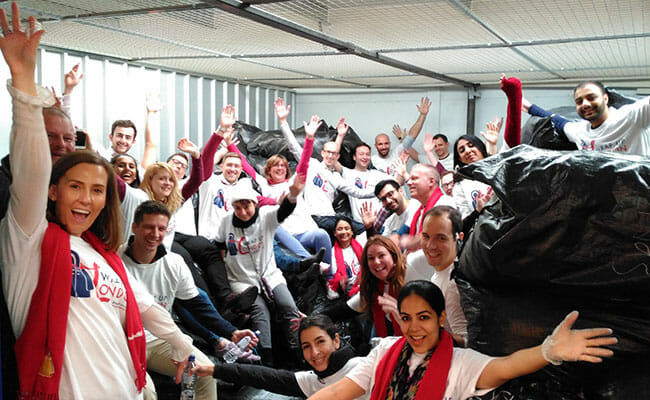
Collecting warm coats for those in need sounds like a blast from the past – an age-old concept straight from a Charles Dickens novel. But wintry winds still squall and recent economic times have dramatically increased the number of homeless people and others in need of warm clothing.
At the same time, people are busier than ever and often struggling to get by themselves. Many are wary of giving money or their time to charities.
That’s why savvy charitable organizations are blasting out new ways to button down the practice of helping others. For example, coat drives are being staged in busy commuter stations, at work and at school, where people have to be anyway. The idea caught on so well in London that it’s spreading to several other cities in the United Kingdom.
Nonprofits are also cooking up better ways to feed the hungry and making it easier to distribute toys for Christmas.
In New York and Rome, fresh, healthy vegetables are joining cans and boxes of nonperishables at food pantries. New York teenagers compete in “Un-Hunger Games” to collect food donations. And in New Jersey, residents are flocking online to buy the exact toy a needy child wants with the click of a mouse, arranging for delivery by Amazon.
Nonprofit organizations that coordinate volunteer projects have embraced the Internet to allow people to browse online and click on opportunities that fit their busy schedules and interests. Social media is being used to spread the word about legitimate ways to help others and to showcase the results. Heartwarming photos are posted, further encouraging the generosity.
During this year’s holiday season, we are proud to shine a spotlight on four Points of Light Network affiliate organizations – each engaged in innovative charitable work that couldn’t be done without dedicated volunteers: Jersey Cares and Volunteer New York! in the United States, and Hands On London and RomAltruista in Europe.
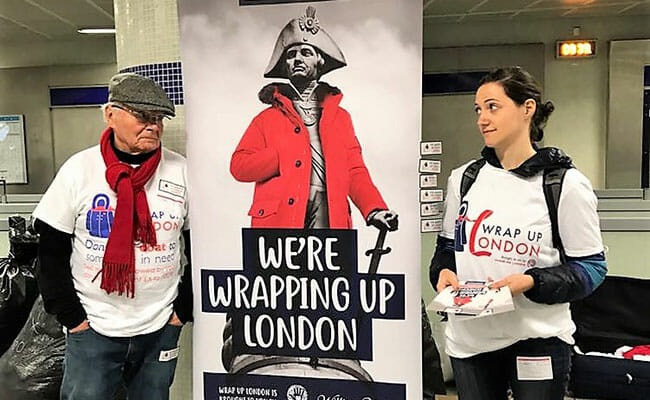
Improved Coat Drives
Wrap Up London, a 7-year-old project of Hands On London, sets up coat donation areas each November in Tube (underground transit) stations, where commuters donated 20,846 coats this year.
Amy Grant, a volunteer with Wrap Up London, says the method resonates with busy working people.
“I was first drawn to the cause because the premise is so brilliant in its simplicity,” Amy said. “Wrap Up London doesn’t ask for money – I love shouting that out when I’m volunteering at a Tube station – and almost everyone has an old coat they can part with.”
The idea proved contagious. Wrap Up Manchester is now in its second year, collecting 1,575 coats this season. Two more cities in the United Kingdom started drives this year: Wrap Up Birmingham (687 coats) and Wrap Up Glasgow (1,000 coats). Now, the city of Nottingham wants its own coat drive, too.
Jon Meech, CEO of Hands On London and project team leader, said the gift of a coat can open the door to other social services for struggling people.
“We know that at this time of year, many people turn up to support services with little other than what they are standing up in,” said Jon. “This is particularly the case for young people finding themselves homeless and women escaping domestic violence, although the lack of warm clothing is an issue for all vulnerable groups. For those living on the streets during the winter, outerwear does not last long.”
Though many nonprofits receive donations of food and clothing throughout the year, they typically do not receive many winter coats, according to Jon. “One women’s refuge commented this year that prior to knowing about Wrap Up London, they were forced to fundraise for the purchase of secondhand coats from thrift shops,” he said. Since Wrap Up London started in 2011, Hands On London has collected and distributed 102,027 warm coats.
Social media and mass transit proved to be key elements in expanding Wrap Up London to other cities in the UK.
The initiative caught the attention of Samra Said, UK programmes manager for Human Appeal – an international relief agency focused on providing humanitarian aid and eradicating poverty – who reached out to Hands On London via Twitter. The Wrap Up London program, said Samra, “embeds our core message of helping the most vulnerable people survive the winter.”
Hands On London provided a license for Human Appeal to use the trademarked “Wrap Up” program name, and extended thorough training and advice to help them launch the initiative, first in Manchester and then in Glasgow and Birmingham. They also negotiated local storage for Human Appeal through some of Hands On London’s corporate partners. Branding, campaign messages and dates are consistent across all four cities.
“At Human Appeal, we believe together we are stronger and we enhance that by working in partnership rather than overlapping,” said Samra.
Wrap Up Manchester also found success in appealing to commuters. It partnered with Network Rail to bring the campaign to Manchester Piccadilly station – collecting 600 coats in three days from Nov. 13-15. Non-commuters could also donate coats to selected self-storage centers across Manchester, Glasgow and Birmingham.
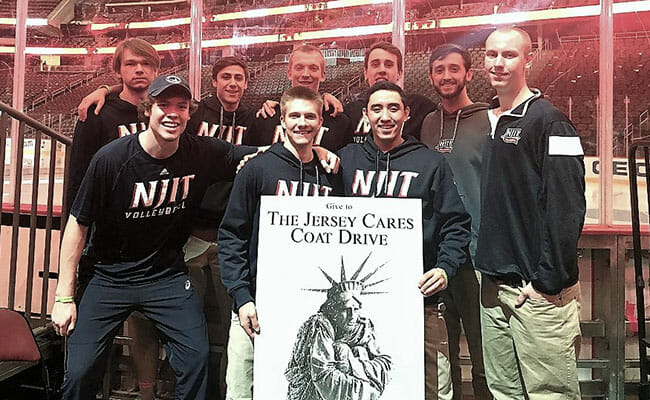
Meanwhile, on the other side of the Atlantic Ocean, Jersey Cares, an organization that links volunteers with worthy causes throughout the state of New Jersey, has held its fall coat drive for 22 years – but staff say they’ve never seen a response like this year, both in the volume of coats donated, and the number of businesses, Scouts and other groups holding collections.
“Just today, we had somebody sign up,” said Vanessa Martinez, Jersey Cares service events manager, on the final day of the event. “Some people who didn’t sign up still want to participate.”
Jersey Cares has been sharing eye-catching photos on social media to remind the public how “cool” winter giving can be. One ad shows the Statue of Liberty shivering without a coat as snowflakes swirl; another shows a cat poking its head from a parka.
“Our social media reach has grown over the past year,” notes Michelle Dee, vice president of external affairs for Jersey Cares. “We try to post pictures of kids getting coats. We talk about how a coat is not a luxury – it’s a senior being able to walk to the store to get medicine on a cold day – people are really able to make that connection.”
Michelle adds that corporate interest has also grown. “We’ve also seen a lot more businesses getting the word out, as well as large corporations doing a coat drive. For example, Robert Wood Johnson Barnabas Health is doing a drive at all 13 of their locations statewide.”
Jersey Cares uses shipping containers to consolidate coats collected at nearly 300 sites. The containers can be driven to shelters, churches and social organizations throughout the state.
This year, a dozen 8-foot tall shipping containers were packed. “Usually, the containers are about half full, and I would say this year, the majority are at least 80 percent full,” said Michelle. “We’re so happy and grateful, especially since I get to tell agencies their requested number will be filled this year, which isn’t always the case.”
And that’s where valuable volunteers come in.
Teams of 10 to 20 people at each location sort, count and examine each coat, making sure it’s clean and usable. Volunteers also separate lighter attire, such as hoodies, hats and gloves, to be distributed elsewhere.
“Our volunteers come together and take all the collected coats, sort and distribute them in one day,” said Vanessa. “We wouldn’t be as successful as we are if not for our volunteers.”
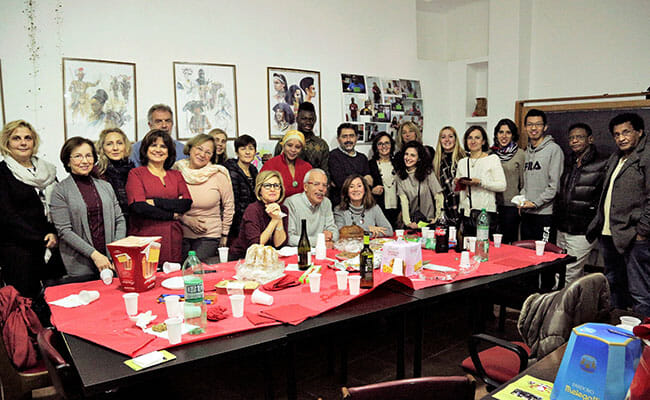
Fleeing War, Finding Hope
RomAltruista, our affiliate in Rome, works tirelessly to help disadvantaged populations find food, shelter, education and jobs. Founded in 2011, it’s had success with “flexible volunteering,” whereby volunteers can browse the organization’s website for projects by theme: animals, environment, elderly, disabled, etc., and sign up for dates by clicking on the online calendar. Schedules are confirmed by email.
In Italy, some of the most vulnerable groups served by RomAltruista are immigrants and refugees. According to a story on BBC posted in July, “more than 500,000 migrants have passed through Italian ports since 2014, and numbers are on the rise again. … Italy is the main destination for migrants attempting to reach Europe by sea, due to its proximity to Libya. According to the United Nations, 83,650 people have reached Italy by sea since the beginning of the year – a 20 percent increase on the same period in 2016.”
Mauro Cipparone, president and co-founder of RomAltruista, coordinates volunteers for several agencies that help the homeless, whether immigrants or native Italians. “Our partner organizations serve food on the streets,” said Mauro. “There are three main train stations in Rome. Every night of the year, at least one organization is serving food there.”
Helping immigrants appeals to Maria Baroni, a retired business professional with experience in organizing events and working with public authorities. She’s become a permanent volunteer with Casa Africa, a RomAltruista partner organization that helps immigrants obtain food, housing, jobs, child care and more.
One of the group’s biggest goals is helping newcomers learn to speak and read Italian, so they can get jobs. Since 2009, Casa Africa has offered an Italian language school at no cost for immigrants and asylum seekers from many areas of the world, including Latin America, China, the Middle East and the Philippines, in addition to Africa. Open four hours a day, five days a week, all months of the year, Casa Africa currently has 250 students. To Maria’s surprise, students even flock to the school in summer, despite the tempting surroundings. “The school is located close to Piazza del Popolo, Piazza di Spagna, Fontana di Trevi, the most attractive places in Rome,” she explained.
“I found my happiness,” Maria said of her volunteer work with Casa Africa. “There are people from different countries; my colleagues are very open-minded. It was perfect for me!”
“We also teach them the fundamental principles of the Italian democratic Constitution,” Maria added with pride. “They have the opportunity to express their opinions about dignity, equality, law, freedom, respect, citizenship, immigrant rights, etc.” Students also visit Italy’s “White House,” the Quirinale Palace presidential residence.
During 2017, about 75 volunteers from RomAltruista helped at the school.
To reach out further to immigrants, RomAltruista launched a new project: Welcome Dinners. “We aim to break the barriers between new arrivals and people who live in Rome,” said Mauro. “At each dinner, there are four locals, four newcomers and one facilitator, and every participant brings food – like a potluck. It helps foreigners and locals get to know each other and counteract bad press – immigrants only seem to appear in the news when there is a crime or something like that. We want people to get to get the direct experience of the immigrants so they can realize they are just normal people.”
Once again, social media generates positive visibility. Participants at Welcome Dinners are asked afterward to post a few words describing their experience on Facebook. Words posted so far include: “warm,” “sharing,” “brotherhood,” “pleasant,” “friendship” and “harmony.”
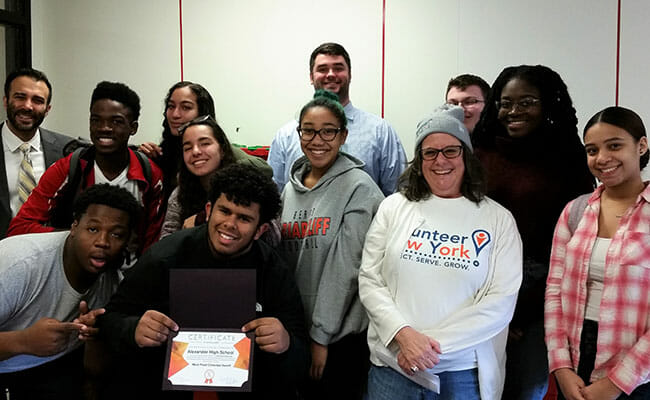
Better Food for Pantries
In New York, donations to food pantries now include fresh, locally grown vegetables, thanks to the efforts of Volunteer New York! The organization, which coordinates a wide variety of volunteer opportunities, has partnered with an energetic gardener, Amy Benerose, who created Our New Way Garden as a way to grow organic produce to serve urban areas that otherwise rely on canned and boxed foods.
“People who have the means can go to farmer’s markets or stores that carry organic produce,” Amy said. “If we really want to help with the problem [of nutrition], we have to make sure everybody gets access to organic food.”
As Amy has expanded from one to five gardens, volunteers are key to getting the produce planted, harvested and delivered.
“Last year, we grew about 20,000 pounds of vegetables and distributed most of them to local food pantries. The quality is really good because it’s grown locally,” said Amy.
The harvest includes corn, eggplant, squash, peppers, melons, pumpkins, lettuce and more, along with herbs and garlic. In addition, Our New Way Garden is raising fruit trees and hopes to build a greenhouse for future year-round crops.
Volunteer New York! uses other creative ideas as part of its Hunger Relief Corps program. Launched in 2015, the program works with soup kitchens, mobile meals for cancer patients and corporate food drives. To make it easier for busy people to donate, “Fill Me Up and Donate Me,” bags are handed out at food pantries, printed with a list of most-wanted items.
During Hunger and Homelessness Week, the “Un-Hunger Games” challenged three high schools to bring in the most food. The initiative was a phenomenal success, with the smallest school bringing in the most donations, said Wendy Armstrong, manager of the Hunger Relief Corps.
In Italy, urban gardens also have sprung up, not only to grow food, but to provide satisfying endeavors for volunteers, including people with disabilities and refugees.
“Its goal is social integration and empowerment for participants,” said Damiano Fiamin, who helps lead the Coltiva Torre garden, located in Rome’s Aniene Valley nature reserve. “We work with the park management, which provides us with water and gives us the boundaries in which we can move without ruining the ecosystem in which we (and another private urban garden) operate.”
Since turning to RomAltruista for help, the garden has found it easier to recruit volunteers, he adds.
Fulfilling Wishes in Just Minutes
Making things easier for donors was the inspiration for Frosty’s Friends, a Jersey Cares project that helps match children with the perfect donated toys. Children selected by social workers, teachers, foster care, etc., are encouraged to write letters to “Frosty,” naming items they want.
“How we differ from a toy drive is that rather than just buying a toy and putting it in a bin, you receive a letter from a child and you get to fulfill that specific wish,” said Jersey Cares’ Vanessa Martinez. “Last year, we filled 2,500 wishes, and this year, we’re well over 4,000 wishes. It’s pretty magical.”
Companies like the ease of distributing Frosty letters among employees. But individuals – even homebound ones – can also join in, easily finding children’s letters on the Jersey Cares social media sites. They can choose from an Amazon wish list that allows them to order and arrange delivery online.
“It’s really a matter of three clicks,” said Jenny Lewellen, senior manager of service events. “It’s really an awesome way for people who don’t have time or the ability to go to a store.” The Amazon donation lists often “sell out” within hours of being posted, she said.
Written by Kay Nolan
